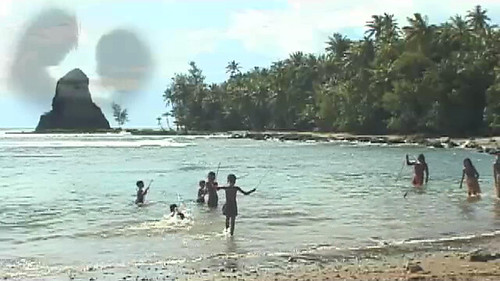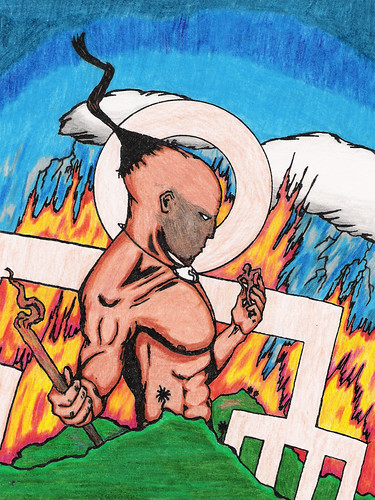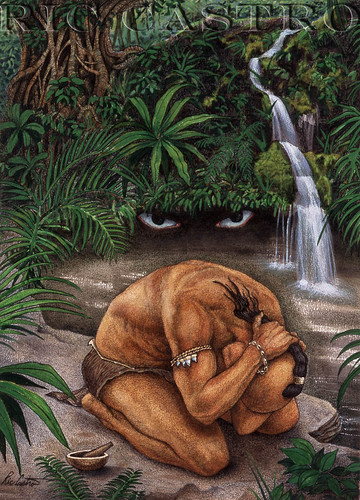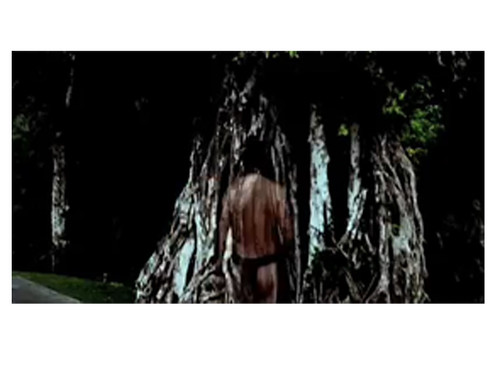Legends of gods
In ancient Chamorro/CHamoru society men were depicted as creators and as having superhuman strength. People used these concepts to attempt to make sense of the complex mysteries of creation and nature.
To this vein, the creation of the universe began with gods. In ancient Chamorro oral tradition the first two gods were a brother and sister, Puntan and Fu’una. Puntan gave up his body to create a universe for people. Puntan and Fu’una decided how to make the universe from parts of his body: one eye became the sun, the other the moon; his eyebrows became the rainbow; his back became the earth; his breast the sky. Mount Tuyan (present-day Barrigada Hill) was from his stomach, and his penis became Laso de Fua (the rock pillar in Fouha Bay found near the present-day Southern village of Humåtak).
Another god was Chaife who inhabited the underworld after the universe was created. He lived in the center of the earth in sasalåguan (hell). He created souls and kept them in sasalaguan torturing them and using them as slaves. Chaife controlled the winds, waves, and fire. One day, one of the souls escaped to Fouha Bay, took the shape of a man and began creating humans using the red earth, water and the sun.
Tales of strength
Many early Chamorro stories and legends are focused on the size and strength of Chamorro men. They tell of men of gigantic size and their superhuman feats of strength. These stories helped to preserve the names of island chiefs and their superhuman feats of strength.
A popular story is of the two rivals of Hagåtña (the island capital) who agreed to a challenge where the most powerful would become chief. One squeezed a rock so hard that water came from it. The other threw a rock that flew as high as a bird. They then fought each other with clubs, and the loser ran away to the district of Tumon in central Guam. From there he jumped to the nearby island of Luta (Rota), nearly forty miles to the north of Guam.
Folklore changed through time
Under Spanish rule (17th -19th centuries), the stories of men changed from tales of strength and size, to those of deception and trickery and even to those filled with depictions of evil spirits such as in the case of the Chamorro ancestral spirits – the taotaomo’na which means “people of before.” As Christianity replaced the ancient Chamorro religion (which incorporated the veneration of ancestors) the tales of the taotaomo’na became lore of non-human male figures who were evil, scary and caused harm to humans who displeased them.
One taotaomo’na is Anufat who is said to have a hole on the side of his head with a birds nest in it. He is said to have a dark complexion and is ugly with six-inch long teeth. Gåtos (an ancient Chamorro word meaning “one hundred”) used his penis as a bridge over rivers and streams so that his men (soldiers) could cross. He is said to cause discomfort to people. For example, if a person urinates in the jungle, and Gåtos is offended, he’ll touch the person’s genital area with his, and this will cause the offender to become sick because they are unable to urinate or move his or her bowels.
For further reading
Cunningham, Lawrence J. Ancient Chamorro Society. Honolulu: Bess Press, 1992.
Le Gobien, Charles. History of the Mariana Islands. Translated by Fr. Paul V. Daly. Mangilao: Micronesian Areas Research Center, 1949.
Mitchell, Roger E. “Patron Saints and Pagan Ghosts: The Pairing of Opposites.” Asian Folklore Studies 45, no.1 (1986): 101-123.
Soker, Donald. “Taotaomona Stores on Guam.” Western Folklore 31, no. 3 (1972): 153-167.
Thompson, Laura M. Archaeology of the Mariana Islands. Bernice P. Bishop Museum Bulletin, No. 100. Honolulu: Bishop Museum Press, 1932.
–––. Guam and Its People. With a Village Journal by Jesus C. Barcinas. 3rd ed. New Jersey: Princeton University Press, 1947.
–––. The Native Cultures of the Mariana Islands. Bernice P. Bishop Museum Bulletin 185. Honolulu: Bishop Museum Press, 1945.




